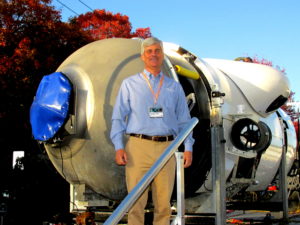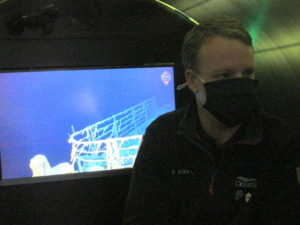By Anne W. Semmes

Welcome to the new world of adventure travel, from deep space now to deep sea. This reporter nearly had a taste of the deep sea perched as I was a week ago in the cutting edge submersible, “Titan,” so designed and built by Seattle entrepreneur Stockton Rush. So, move over Elon Musk with your Space X and Richard Branson with your Virgin Galactic, Stockton Rush is inviting you down to the Titanic. But his bucket list includes scores of ancient shipwrecks, WWII aircraft, and those strange hydrothermal vents that Rush cites as one of the great discoveries of the last century.
“Half of our mission specialists [paying explorers] are also Virgin Galactic customers,” confirms Rush, “and about a quarter have climbed Everest.” We’re tucked up inside the Titan that’s docked before the Greenwich Water Club and I’m a little disappointed we’re not beneath Cos Cob Harbor. The invite read guests would be taken into the sub five at a time for 15 minutes…but I’d missed that word simulated.
Rush obtained his BSE in Aerospace Engineering from Princeton University, hence there were Princeton grads on the guest list. He tried space travel becoming the youngest jet transport rated pilot in the world, age 19. Built his own experimental aircraft, which he still owns and flies, then fabricated a two-man submersible he uses when he’s not running OceanGate Inc., “the leading provider of crewed submersibles for charter and scientific research.”

So, when did he decide to go from deep space to deep sea? “When I saw the launch of SpaceShipOne, Paul Allen’s and Burt Rutan’s plane that went up in 2003, and I thought I don’t want to be a space tourist. I want to be an explorer.”
Last summer was Rush’s first Titanic Expedition with his now two-year-old state of the art Titan.
So what’s that expedition all about? Helping people relate to the deep ocean? “That’s part of why I started this project, why we have five people, why we always have researchers, why the sub is laid out how it is – it’s all about engaging people, why we can put it on a truck and bring it here and show it to people. You can’t do that with any of the other deep diving subs. They’re dedicated to a ship and people don’t get to see them. So really getting people to see the vessel, see things like the Titanic…And that’s how you get people excited about the ocean, and exploring the ocean. The mismatch between what we spend in space and what we spend in the ocean is embarrassing.”

But the fee for that individual exploration is a quarter of a million dollars. Travel time in 2022 will be between late May and September. The first trip is already booked. Take off is from St. John’s Newfoundland, on the Dive Support Ship, the Horizon Arctic, taking passengers, sub, and the necessary launch recovery platform. “One of the unique features of the sub is it’s not dedicated to a ship so the Alvin and even James Cameron’s sub are all dedicated to a specific ship with specific equipment. We have our own launch platform so we can operate from any ship. We just tow out to the location; the whole thing sinks and then the sub takes off.”
So, a day and half out with five days on site, and down you go 12,500 feet to the Titanic. Two and half hours down, hour and a half up.
So, who owns the Titanic rights? “That’s much longer than your article can go into,” he quips. “The salvage rights for whatever value are held by a company called RMS Titanic. They’ve salvaged 5,500 artifacts from the Titanic. When the company went bankrupt, the company was sold at auction. The relics that they recovered they still have. It’s also a UNESCO World Heritage Site, but only 22 countries signed the UNESCO treaty. But generally, so few people can get to it that it is protected by its remoteness.” But this reporter recalled featuring on the NBC Today Show William F. Buckley’s dive to the Titanic with a French crew a year after Bob Ballard first found it in 1985. Buckley had mischievously unveiled a gift given him by the French divers from the wreck – a pencil.

So, what are the prerequisites for boarding the Titan? “You’ve got to be over 18. You have to be physically able – so we define physically able to climb a ladder, able to stand up without help.” And yes, just like that now space veteran actor William Shatner, the Titan has taken down a 92-year-old.
“Shipwrecks are artificial reefs,” says Rush, “So you get a lot of biomasses down there. The nice thing is they don’t move. It’s hard to find whales. They move around. Shipwrecks stay put. The life forms around them. They have a story. They’re engaging. They’re fun to get down to and see. There are other great things in the ocean, but they’re much more random like jellyfish – they’ll show up, but sometimes they won’t. And dolphins and whales, same thing.”
Following our interview, I had my 15 minutes with nearly nine-year OceanGate veteran pilot Scott Griffith. He showed a video of the wreck with life crawling over it – small white crabs. So, do crabs morph white in the dark deep? Something to explore, like those hydrothermal vents.
Rush described their wonder. “The magma from the inside of the earth comes up into the ocean and creates this giant hot vent. And it’s the highest density of biomass on the planet.” Such “chemosynthetic organisms that live without photosynthesis” had he said “completely changed NASA’s perception of where life exists…These are life forms that probably exist throughout the universe.”
Deep sea meets deep space.

Guests were then treated to drinks and hors-d’œuvres as Rush showed a Titanic Expedition explanatory film. At my table was Greenwich jeweler, the adventurous Terry Betteridge with his son-in-law Jake Skinner. “We both loved the idea of adventure into such foreign country,” shared Betteridge, “far north, far at sea and on a ship of the most specialized design imaginable: An iceberg pulling behemoth.” But what might pull stronger would be, “other trips they take to see creatures almost never seen and so little is known about.” His son-in-law agreed. He would await “the nature trip to some more fertile deep. “
Former First Selectman Lolly Prince was also present, and game to go. “A superb opportunity for an adventurer!!” she shared. “The visual experience of going 2 1/2 miles under the surface of the ocean in the capsule and ending at the wreck of the Titanic was so well replicated for us as visitors in the capsule!”
It was friend Valerie Stauffer whose son Chris was a Princeton pal of Rush’s who put my name on the guest list. She had her Titan visit last Saturday. Sitting in the Titan she imagined herself 12,000 feet deep “viewing the actual remains of the original wheel of the Titanic and the personal belongings left by the ill-fated passengers.” She realized she said, “that the Titan would show me the sunken ship far better than any fictional movie could.”





